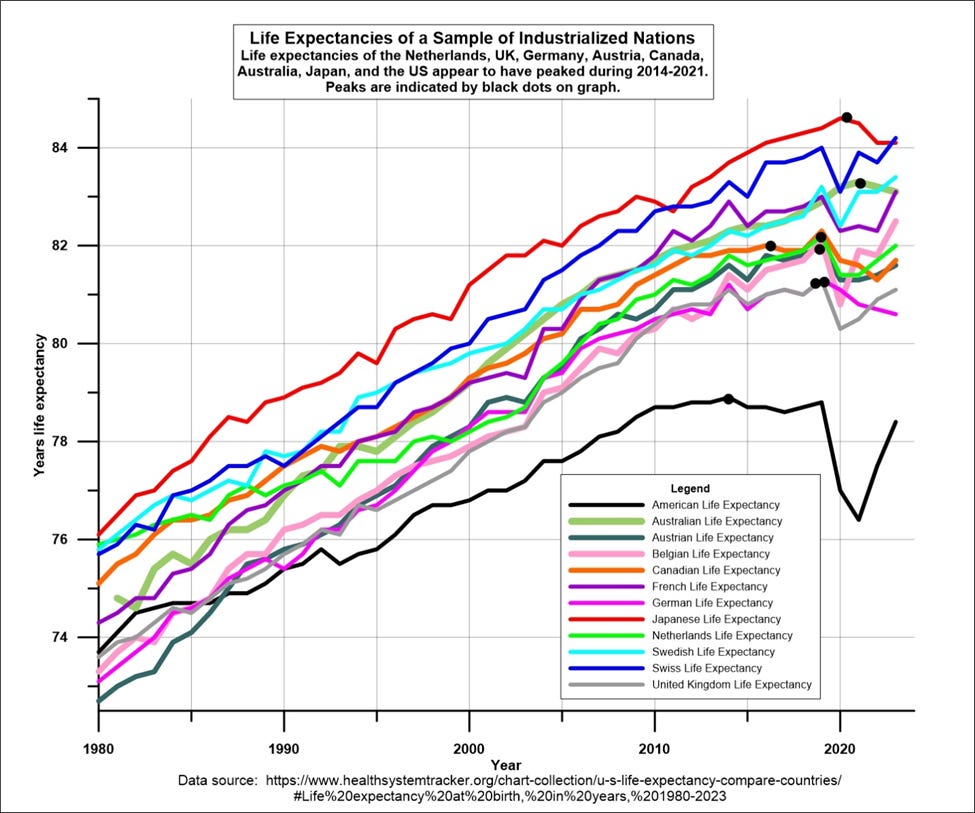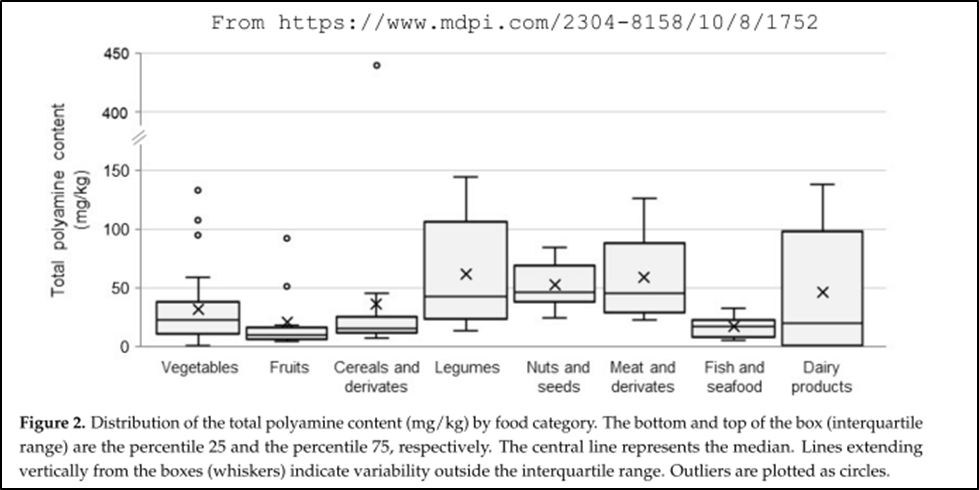A Systems Hypothesis Nicely Explaining Both the American Hispanic Paradox and the Relatively Low (and Decreasing) Average American Lifespan
A peas, corn, and beans, meat and potatoes, and fossil fuels depletion story
If basic energy and protein needs are taken care of pretty much equally by any given type of human cuisine, why might particular food preferences still make a substantial difference in health and longevity? One always possible reason is differences in the relative availability of trace or minor limiting factor nutrients like vitamins, particular fatty acids, or minerals.
From Wikipedia: “Liebig's law of the minimum, often simply called Liebig's law or the law of the minimum, is a principle developed in agricultural science by Carl Sprengel (1840) and later popularized by Justus von Liebig. It states that growth is dictated not by total resources available, but by the scarcest resource (limiting factor). The law has also been applied to biological populations and ecosystem models for factors such as sunlight or mineral nutrients.
This was originally applied to plant or crop growth, where it was found that increasing the amount of plentiful nutrients did not increase plant growth. Only by increasing the amount of the limiting nutrient (the one most scarce in relation to "need") was the growth of a plant or crop improved. This principle can be summed up in the aphorism, "The availability of the most abundant nutrient in the soil is only as good as the availability of the least abundant nutrient in the soil." Or the rough analog, "A chain is only as strong as its weakest link."
Read now a short summary review (Bardocz 1995) of the nature and functions of polyamines in the bodies of people and other animals [emphases added]:
“Like other growth factors, putrescine, spermidine and spermine are involved in every step of DNA, RNA and protein synthesis, and are thus essential for cell proliferation and growth. In contrast with metal ions, which have localized charges, polyamines can form bridges between, and therefore connect with, distant negatively charged structures because of the positive charges distributed along their hydrocarbon chain…
Polyamines are very stable compounds that are able to resist heat and survive acidic or alkaline conditions. They can interact non-specifically with negatively charged structures and, in these non-specific roles, they can be replaced by metal ions, most often Mg2+ or Ca2+. Because of their structures, they can fulfill a wide range of uniquely specific functions in cells, such as the control and initiation of the translation of mRNA to form proteins and also regulation of the fidelity of the translation. Polyamines can stimulate ribosome subunit association, stabilize the tRNA structure and reduce the rate of RNA degradation, enhance both RNA and DNA syntheses, help to condense DNA, covalently modify proteins as well as regulate the rigidity and stability of cellular membranes.
However, the most important function of polyamines, one in which they cannot be replaced by any other positively charged molecules, is to act as secondary messengers, thereby mediating the action of all known hormones and growth factors. Thus, the polyamines fulfill indispensable roles in human metabolism.”
Next, recall that as people and other animals age, they become more and more dependent on food sources for those limiting factors, spermidine and spermine, because their bodies gradually become less and less efficient at manufacturing these small molecules internally. Over the span of a human life, therefore, endogenously-generated polyamines become a limiting factor hindering the growth and repair of the human body.
It is not surprising, then, that Kiechl et al. found that average human healthspan/longevity increased by almost 6 years in America for people eating a diet with only a marginally higher than average dietary content of spermidine:
“To our knowledge, our study is the first to show an inverse relation between the amount of dietary spermidine intake and all-cause mortality in the general community (Table 2). The association emerged as independent of other determinants of longevity and lifestyle. The survival advantage was driven by a reduced risk of death from all major causes. The key association was highly consistent in subgroups (Figure 2) and successfully replicated in an independent cohort from the same geographical region. It exhibited a linear dose-response type and particular strength. Spermidine showed the strongest inverse relation with mortality among 146 nutrients studied (Supplemental Figure 4). The reduction in mortality risk related to a diet rich in spermidine (top compared with bottom third of spermidine intake) was comparable to that associated with a 5.7-y younger age. All of the findings apply to spermidine from dietary sources and to amounts characteristically found in the Western diet and cannot readily be extrapolated to high-dose spermidine supplementation or extreme diets.” [Emphases added.]
The less healthy, and biochemically faster-aging group in the bottom third of daily dietary spermidine consumption in the Kiechl study over the long run ate a diet containing 9.0 mg/day or less of the substance. On the other hand, the healthier and 5.7 years biologically younger group, that in the top third of daily spermidine consumption, took in 11.6 mg/day or more of the substance – a minimum of just two or three milligrams more each day. Not much of a dietary difference for such a very large epidemiologically-evident health-increasing advantage.
This within-the-US limiting factor behavior of spermidine also shows up internationally when comparing the average life expectancies of different countries, and appears to explain up to about 60% of the US life expectancy deficit compared to the life expectancy levels of the average person in most of the other industrialized countries. See Figures 1 and 2.


What is it about the dietary proclivities of the average person in the US that could be causing this polyamine and life expectancy deficit in America? There’s evidence to suggest the problem in the US has come about because of adoption of an ersatz, ineffective form of the country’s traditional Northern European dietary pattern.
In those countries following the Northern European dietary pattern, the central staple foods are meats, fish, and/or dairy products -- accompanied by complements and accessories of vegetables, starchy foods, and condiments. On the other hand, in those Asian, Mediterranean, Latin American, and African countries following the other major manner of human eating, grains, legumes, and/or tubers fulfill the role of the staple part of the diet, and meats, fish, and non-starchy vegetables function only as minor complementary and accessory foods.

You can see in Figure 4 that in the Northern European dietary pattern, limiting factor polyamines like spermidine are obtained chiefly by eating large (main course) amounts of staple meat and dairy products. In the alternative (Mediterranean-Asian-Latin American-African) dietary pattern,1 however, polyamines are instead chiefly taken in by consuming staple legumes, nuts, and seeds, and only complementary or accessory amounts of meat and dairy.

Consideration of the Hispanic Paradox in the US provides one key (of two) for decoding why the average American lives 4 to 6 less years than the average citizen in most of the other industrialized nations. Hispanic Americans, largely following Latin American eating habits that are not so reliant on meat had an average life expectancy of 82.2 years in 2019, while White non-Hispanic Americans at the same time had an average life expectancy of 78.9 years. This very substantial difference exists despite the greater general economic advantage of the average non-Hispanic White American over the average Hispanic American. Figure 5 further details the deep nature of the Hispanic American health advantage.

So, what gives here? To obtain the second key to answering this question, take a look at the inflation-corrected average price of commercially-processed meat from 1949 to the present in Figure 6. It is clear in this graph that meat prices in the US have been climbing since the first depletion-caused oil shocks of the 1970s. For most people in the US, this continuing price pressure has been sufficient to force grocery substitutions, gradually but materially moving Americans away from their traditional Northern European meat-centric dietary pattern to something entirely different – not a Northern European diet or the Mediterranean-Asian-Latin American-African alternative – but a pale, puffy ersatz imitation of the traditional Northern European pattern of eating.

With the rise of meat prices, the average diet in the US began substituting polyamine-poor refined flour products for staple meat-dominant main dishes. Witness in Figure 7 the timing of the consequent rise, for example, of the term, “hamburger helper”, in the American food lexicon.

As you can see below in Figure 8, meat substitutions or ‘helpers’ made out of refined flours are much poorer sources of the limiting factor polyamines than is meat. So, in the US while average Americans were inadvertently shortening their lives by reducing the amount of meat (and dairy foods like sharp cheddar cheese) in their diet, the average American Hispanic instead steadily steamed on healthwise, continuing unchecked to get the ample polyamines implicit in their less expensive Latin American cuisine.2

And also — like other Americans — benefiting from technological and scientific progress in formalized healthcare.

